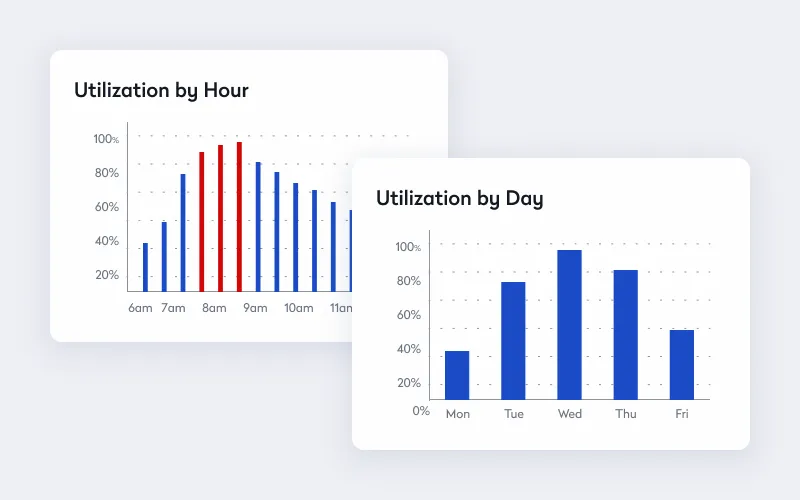
Space occupancy and space utilization have always been important metrics to measure in your workplace, but in the hybrid environment, they’re even more critical. Over time, poor space utilization leads to waste, while also affecting employee experience. The office should be a hub for collaboration and innovation, but when people come to the office and find it’s either overcrowded or abandoned, they’re less likely to come back.
But by tracking the right metrics, you can right-size your corporate real estate portfolio, delivering a strong employee experience that helps you retain top talent and boosts the bottom line.
How to measure office space occupancy
Space occupancy refers to the number of people in your office during a given period. It’s an important metric because it determines how much space the company needs to support its employees.
Aside from the cost of employing your workforce, office space is likely one of your organization’s largest investments. It also tends to be the most challenging to manage. Space utilization calculations used to be a matter of looking at seat assignments to see the percentage of occupied workspaces compared to the percentage of vacant spaces, but it’s not that simple anymore.
First, you need to determine what the ideal occupancy should be for each office space. That will depend on the types of spaces you have and how employees need to use them.
Assuming your workplace has moved away from assigned seats, there are several ways to measure office space occupancy, including automatically captured data from:
- Employee badge swipes that track the number of people in the office
- Desk hoteling that requires employees to reserve workspaces
- Visitor management, where employees sign in but are free to sit anywhere
- Sensors that track real-time occupancy
Monitoring space occupancy gives you greater insight into how much space is in use and how much is available for future growth.

Office space occupancy metrics
Part of the process is deciding how much space each employee needs on average, but that doesn’t mean every workspace needs to be this size. Common areas and conference rooms are part of this equation, too — and with the size of the average workspace shrinking, they’re becoming even more important.
It sounds simple, but facilities managers can’t accurately reach square footage per employee without first knowing the true occupancy of their facility.
To determine occupancy, you need to know:
- The total building capacity
- The square footage of usable workspace
- The total number of employees
You can then set target occupancy rates and monitor occupancy in your offices. Although a 60% occupancy rate was average in the past, you may need to adjust your target to account new trends in the workplace.
For example, there’s a mid-week mountain, where across industries and around the world, workers are tending to come to the office on Tuesdays, Wednesdays, and Thursdays, according to proprietary research in Eptura’s H1 2024 Workplace Index. The report leverages anonymous user data from more than 5,000 companies, including 19,000 buildings, 95.5 million desk bookings, and 25 million room bookings.
How to measure space utilization
While office space occupancy is important, space utilization data measures who is using a space, why they’re there, and what they’re doing. With this data, workplace managers can determine whether the workforce is using the space efficiently to serve current and future business goals.
Here are a few key questions that will help you evaluate and measure space utilization metrics:
- How big is your average workstation?
- What is the ratio of employees to workstations?
- Is it possible for some employees to share desks if they aren’t in the office every day?
- How often are employees using the conference rooms?
With occupancy sensors, you can see the spaces workers are using at any given time and identify patterns to help you plan. With accurate data, you can see the big picture, right down to the smallest detail.
Space utilization metrics
The space utilization metrics that are most important to you depend on your goals for tracking them. Here are a few of the most common metrics:
- Average utilization
- Peak utilization
- Peak frequency
- Meeting room utilization rates
- Average desk occupancy
Peak utilization is the maximum number of employees occupying a particular part of the office, such as a meeting room. Peak frequency is a measurement of how often a space achieves maximum utilization in each period.
Monitoring peak utilization and peak frequency can help you identify office space occupancy patterns. You can see when your office is most populated and make sure you have the space required to support your needs.

Knowing your average room utilization and desk occupancy helps you adjust the layout of your office space to meet demand. If your rooms are often underutilized but your desks are nearly always occupied, you might consider converting some meeting room space into reservable desks.
How space management software makes utilization data actionable for corporate real estate
While there are several ways to track office space occupancy and space utilization, space management software allows you to act immediately on what you learn and plan.
You can see which spaces are reserved or occupied in real time. You can gather historical space utilization trends and see sensor data directly overlaid on your digital floor plans for the most accurate insights.
As you draw conclusions, you can easily update your floor plans and experiment with new move scenarios. Rather than having to survey each space, space management software allows you to visualize your space and provides you with the ability to report on your actual space utilization. That way, you can see the big-picture information in addition to specific details, like total area, location, buildings’ floor-by-floor, and space-by-space utilization metrics.
This, combined with sensor data, allows you to track activity and generate a far more detailed report about how many occupants your facility supports throughout the day, where they spend the most time, and how they use different spaces.
From these reports, you can maximize your space utilization and minimize costs. You can determine if employees use space efficiently, if the space meets their needs, and if there is an opportunity to upgrade or downsize to increase productivity or decrease costs.
The more you know about the way your space is currently used, the better you can plan. to optimize your workplace and improve workplace experience, you need to understand how space is being used and know how things are changing.
And at a time when budgets are tight, you also must make sure you’re paying attention to operating costs and maximizing the use of the corporate real estate you do have. In the end, by better understanding both your space occupancy and space utilization metrics, you can improve your bottom line.








